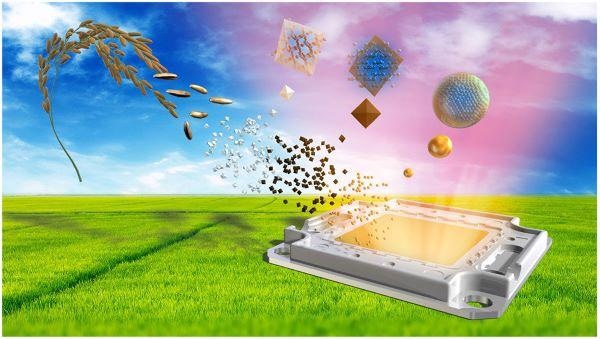Reviewed by Alex SmithApr 13 2022
Each year, about 100 million tons of rice husk waste is produced by milling rice to separate the grain from the husks. Researchers seeking a scalable method to fabricate quantum dots have created the first silicon quantum dot (QD) LED light by recycling such rice husks.
 World’s first LED light from rice husks. Scientists from Hiroshima University created the world’s first LED light by using rice husks and chemically obtained products. Image Credit: Reproduced from ACS Sustainable Chemistry & Engineering, 2022. Copyright ACS.
World’s first LED light from rice husks. Scientists from Hiroshima University created the world’s first LED light by using rice husks and chemically obtained products. Image Credit: Reproduced from ACS Sustainable Chemistry & Engineering, 2022. Copyright ACS.
The new technique converts agricultural waste into cutting-edge light-emitting diodes at a low cost and with minimal environmental impact.
The scientists from the Natural Science Center for Basic Research and Development, Hiroshima University, published their findings on January 28th, 2022, in ACS Sustainable Chemistry & Engineering, the American Chemical Society journal.
Since typical QDs often involve toxic material, such as cadmium, lead, or other heavy metals, environmental concerns have been frequently deliberated when using nanomaterials. Our proposed process and fabrication method for QDs minimizes these concerns.
Ken-ichi Saitow, Study Lead Author and Professor, Chemistry, Hiroshima University
Since its discovery in the 1950s, porous silicon (Si) has been studied for use in luminescent materials, lithium-ion batteries, drug delivery systems and biomedical sensors. Si has photoluminescence properties due to its microscopic (quantum-sized) dot structures that function as semiconductors. It is non-toxic and abundant in nature.
The investigators set out to find a new technique for constructing quantum dots that have a positive environmental impact, after learning about the environmental concerns surrounding current quantum dots. It turns out that waste rice husks are a great source of high-purity silica (SiO2) and value-added Si powder.
To process the rice husk silica, the researchers used a combination of milling, heat treatments and chemical etching. Initially, they milled rice husks and obtained silica (SiO2) powders by burning off organic compounds in the milled rice husks.
They then used an electric furnace to heat the resulting silica powder, resulting in Si powders through a reduction reaction. The final product was a purified Si powder that was chemically etched down to 3 nm in size.
Lastly, its surface was chemically functionalized with 3 nm crystalline particles for high chemical stability and solvent dispersivity, resulting in SiQDs that luminescence in the orange-red range with a high luminescence efficiency of over 20%.
“This is the first research to develop an LED from waste rice husks,” comments Saitow. The professor also adds that silicon’s non-toxic quality makes them an attractive alternative to existing semiconducting quantum dots.
The present method becomes a noble method for developing environmentally friendly quantum dot LEDs from natural products.
Ken-ichi Saitow, Study Lead Author and Professor, Chemistry, Hiroshima University
The LEDs were assembled as a series of material layers. The LED anode was an indium-tin-oxide (ITO) glass substrate, which is a good conductor of electricity while being sufficiently transparent for light emission. Additional layers, including the layer of SiQDs, were spin-coated onto the ITO glass. The material was capped with an aluminum film cathode.
The optoelectrical and optical properties of the SiQD light-emitting diode, including the synthesis yields, structures, and properties of the SiO2 and Si powders and SiQDs, were evaluated using the chemical synthesis method developed by the researchers.
By synthesizing high-yield SiQDs from rich husks and dispersing them in organic solvents, it is possible that one day these processes could be implemented on a large scale, like other high-yield chemical processes.
Ken-ichi Saitow, Study Lead Author and Professor, Chemistry, Hiroshima University
The group’s next goal is to improve the efficiency of luminescence in SiQDs and LEDs. They also intend to look into producing SiQD LEDs in colors other than the orange-red they have just created.
In the future, the scientists believe that the method they developed could be applied to other plants that contain SiO2, such as wheat, sugar cane bamboo, grasses and barley. These natural products, as well as their byproducts, may have the potential to be converted into non-toxic optoelectronic devices. Finally, the scientists hope to see this environmentally friendly method of making luminescent devices from rice husk waste commercialized.
Honoka Ueda, Shiho Terada, and Taisei Ono, from Hiroshima University, were also part of the research team.
The study was financially supported by Next Generation World-Leading Researchers of the Japan Society for the Promotion of Science (JSPS), Grants-in-Aid for Scientific Research from JSPS, the PRESTO Structure Control and Function program of the Japan Science and Technology Agency, and The Japan Keirin Autorace Foundation (JKA).
Journal Reference:
Terada, S., et al. (2022) Orange–Red Si Quantum Dot LEDs from Recycled Rice Husks. ACS Sustainable Chemistry & Engineering. doi.org/10.1021/acssuschemeng.1c04985.